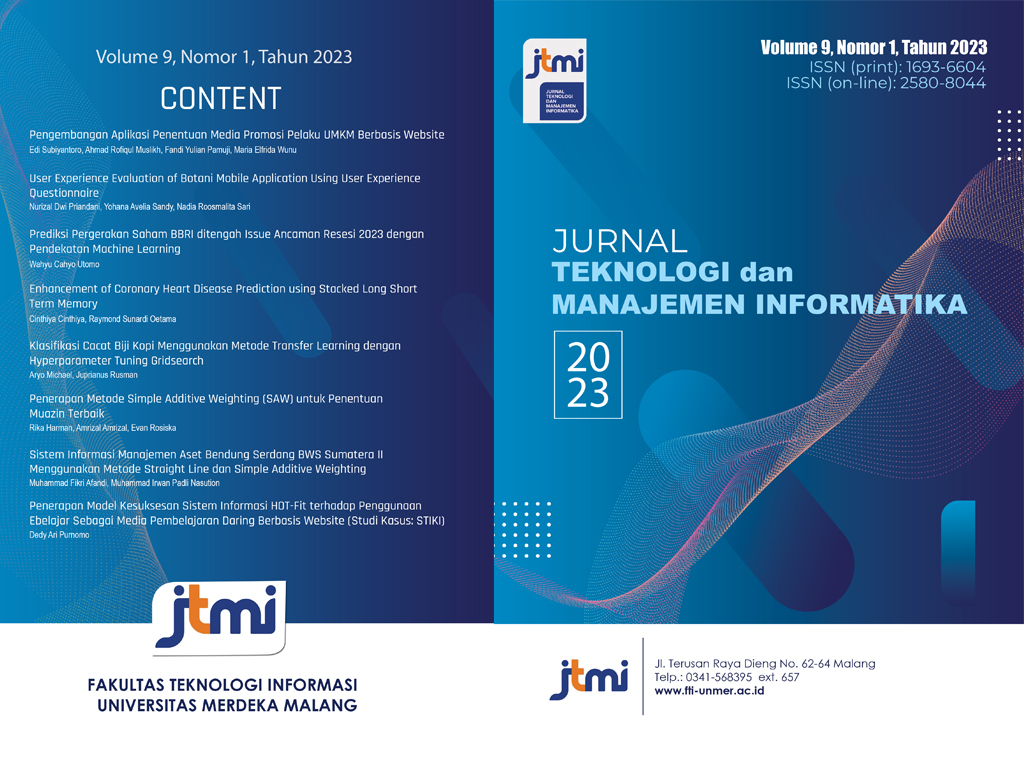Klasifikasi Cacat Biji Kopi Menggunakan Metode Transfer Learning dengan Hyperparameter Tuning Gridsearch
DOI:
https://doi.org/10.26905/jtmi.v9i1.10035Keywords:
Deep Learning, Transfer Learning, Classification, Hyperparameter Tuning, Coffee Beans,Abstract
Defects in coffee beans can significantly impact the quality of coffee production, which can lead to a decrease in the price of coffee beans in the global coffee market. Currently, coffee bean sorting is still conventionally done to separate defective and non-defective coffee beans, which is a time-consuming process and subject to subjective selection, potentially leading to a decline in the quality of the resulting coffee beans. The objective of this research is to design and measure the performance of deep learning algorithms, CNN MobilNetV2 and DenseNet201, using transfer learning methods where hyperparameter tuning grid search is employed to select the optimal combination of hyperparameters for the defective coffee bean classification model. The study began by collecting a dataset of images of abnormal and defective coffee beans, building a classification model using transfer learning methods that utilized pre-trained models and selecting the best hyperparameters, training the model, and finally testing the created classification model. The research results indicate that the pre-trained MobileNetV2 model with hyperparameter tuning achieved an accuracy of 90%, and the pre-trained DenseNet201 model achieved an accuracy of 93%. The research results indicate that this approach enables the model to achieve excellent performance in recognizing and classifying defective coffee beans with high accuracyDownloads
References
I. Mawardi, H. Hanif, J. Jennifar, and S. Safaruddin, Penerapan Mesin Sortasi Dalam Upaya Efesiensi Proses Produksi Kopi Gayo Sebagai Produk Unggulan Daerah Aceh Tengah, J. Bakti Masy. Indones., vol. 3, no. 2, pp. 476-485, 2021, doi: 10.24912/jbmi.v3i2.9400.
S. Abdoellah and D. Hartatri, F.S, Analisis Kinerja dan Prospek Komoditas Kopi, Anal. dan Opini Perkeb., vol. 2, no. 2, pp. 1-7, 2021.
A. de S. Silveira, A. C. T. Pinheiro, W. P. M. Ferreira, L. J. da Silva, J. L. dos S. Rufino, and N. S. Sakiyama, Sensory analysis of specialty coffee from different environmental conditions in the region of Matas de Minas, Minas Gerais, Brazil TT - Análise sensorial dos cafés especiais da região das Matas de Minas cultivados em diferentes condições ambientais, Rev. Ceres, vol. 63, no. 4, pp. 436-443, 2016, doi: https://doi.org/10.1590/0034-737X201663040002.
E. R. Arboleda, A. C. Fajardo, and R. P. Medina, An image processing technique for coffee black beans identification, 2018 IEEE Int. Conf. Innov. Res. Dev. ICIRD 2018, no. May, pp. 1-5, 2018, doi: 10.1109/ICIRD.2018.8376325.
A. Rahmawati, Y. Rianto, and D. Riana, Deteksi Defect Coffee Pada Citra Tunggal Green Beans Menggunakan Metode Ensamble Decision Tree, Techno.Com, vol. 20, no. 2, pp. 198-209, 2021, doi: 10.33633/tc.v20i2.4529.
M. Jumarlis, ; Mirfan, ; Abdul, and R. Manga, Classification of coffee bean defects using gray-level co-occurrence matrix and k-nearest neighbor, Ilk. J. Ilm., vol. 14, no. 1, pp. 1-9, 2022, [Online]. Available: http://dx.doi.org/10.33096/ilkom.v14i1.910.1-9
C. Pinto, J. Furukawa, H. Fukai, and S. Tamura, Classification of Green coffee bean images basec on defect types using convolutional neural network (CNN), in 2017 International Conference on Advanced Informatics, Concepts, Theory, and Applications (ICAICTA), 2017, pp. 1-5.
S. J. Chang and C. Y. Huang, Deep learning model for the inspection of coffee bean defects, Appl. Sci., vol. 11, no. 17, 2021, doi: 10.3390/app11178226.
R. Siddiqi, Effectiveness of Transfer Learning and Fine Tuning in Automated Fruit Image Classification, in Proceedings of the 2019 3rd International Conference on Deep Learning Technologies, 2019, pp. 91-100. doi: 10.1145/3342999.3343002.
L. Alzubaidi et al., Review of deep learning: concepts, CNN architectures, challenges, applications, future directions, vol. 8, no. 1. Springer International Publishing, 2021. doi: 10.1186/s40537-021-00444-8.
L. Alzubaidi et al., Review of deep learning: concepts, CNN architectures, challenges, applications, future directions, J. Big Data, vol. 8, no. 1, p. 53, 2021, doi: 10.1186/s40537-021-00444-8.
D. M. Belete and M. D. Huchaiah, “Grid search in hyperparameter optimization of machine learning models for prediction of HIV / AIDS test results, Int. J. Comput. Appl., no. September, 2021, doi: 10.1080/1206212X.2021.1974663.
W. Nugraha and A. Sasongko, Hyperparameter Tuning pada Algoritma Klasifikasi denganGrid Search, Sist. J. Sist. Inf., vol. 11, no. 2, pp. 391-401, 2022.
A. G. Howard et al., MobileNets: Efficient Convolutional Neural Networks for Mobile Vision Applications, 2017. [Online]. Available: http://arxiv.org/abs/1704.04861
G. Huang, Z. Liu, L. Van Der Maaten, and K. Q. Weinberger, Densely connected convolutional networks, in Proceedings - 30th IEEE Conference on Computer Vision and Pattern Recognition, CVPR 2017, 2017, vol. 2017-Janua, pp. 2261-2269. doi: 10.1109/CVPR.2017.243.
K. Dong, C. Zhou, Y. Ruan, and Y. Li, MobileNetV2 Model for Image Classification, in Proceedings - 2020 2nd International Conference on Information Technology and Computer Application, ITCA 2020, 2020, pp. 476-480. doi: 10.1109/ITCA52113.2020.00106.
A. Faizin, A. Tri Arsanto, Moch. Lutfi, and A. Rochim Musa, Deep Pre-Trained Model Menggunakan Arsitektur Densenet Untuk Identifikasi Penyakit Daun Padi, JATI (Jurnal Mhs. Tek. Inform., vol. 6, no. 2, pp. 615-621, 2022, doi: 10.36040/jati.v6i2.5475.
Amir, Supri Bin Hj, and Bagas Prasetyo, Comparison of Elliptic Envelope Method and Isolation Forest Method on Imbalance Dataset, Jurnal Matematika, Statistika Dan Komputasi, 17.1 (2020), 42-49. doi: 10.20956/jmsk.v17i1.10899
Downloads
Published
Issue
Section
License
Copyright (c) 2023 Jurnal Teknologi dan Manajemen Informatika

This work is licensed under a Creative Commons Attribution-ShareAlike 4.0 International License.
Authors who publish with this journal agree to the following terms:
(1)Â Copyright of the published articles will be transferred to the journal as the publisher of the manuscripts. Therefore, the author confirms that the copyright has been managed by the journal.
(2) Publisher of JTMI: Jurnal Teknologi dan Manajemen Informatika is University of Merdeka Malang.
(3) The copyright follows Creative Commons Attribution–ShareAlike License (CC BY SA): This license allows to Share — copy and redistribute the material in any medium or format, Adapt — remix, transform, and build upon the material, for any purpose, even commercially.




